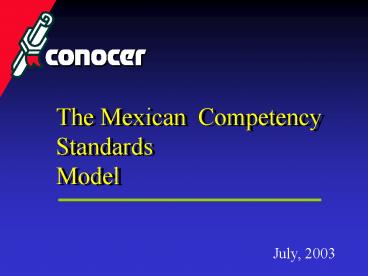July, 2003 - PowerPoint PPT Presentation
Title:
July, 2003
Description:
Model July, 2003 1.- El lector percibir a m s claramente el contenido de la norma si se considera: La correspondencia de la Norma.- Cada evidencia con su respectivo ... – PowerPoint PPT presentation
Number of Views:49
Avg rating:3.0/5.0
Title: July, 2003
1
July, 2003
2
Mexican labor situation before NAFTA
OFFER BASED ECONOMY
ARTIFICIAL STABILITY IN LABOR MARKET
POOR CORDINATION BETWEEN WORKING CENTERS AND
EDUCATIONAL SUPPLY
3
Human talent managment by a competency model
DEMAND BASED ECONOMY
CHANGE IN WORKFORCE REQUIRED ABILITIES
KNOWLEDGE BASED ECONOMY
INFORMATION AND COMUNICATION TECHNOLOGY
COMPETENCY STANDARDS MODEL
NEW HUMAN ABILITIES
4
Technical Education and Training Modernization
Project (PMETYC)
The PMETyC started its formal operation in
September 1995, operated by the Public Education
ministry and Work and Social Welfare Ministry
GOAL
To supply enterprises with relevant and high
quality educational services according to their
requirements of productivity and
competitiveness, by
- Developing linkages between work supply and
demand - Supporting standards based training and
certification for - unemployed people and active workers
5
PMETYC
COMPONENT S
Normalization and Certificación Systems
A (CONOCER)
Curricula Transformation and
Update
B Education Secretary and Training
Providers
Support to Private Sector Use of Competency
Standards in Training Programs
C Labor Secretary (STPS)
Information Systens, Evaluation and Research
D (CONOCER, SEP, STPS)
6
PMETYCs financial schema
- 200 million USD World Banks loan
- 3 million USD grant from the Interamerican
- Development Bank for CONOCER Pilot Projects
- Resources from Mexican Federal Government
7
PMETYCs strategy
Period
Phases
Instrumentation of Labor Standards National
System (SNCCL) and development of experimental
institutional cases
1995-1997
Expansion of the SNCCL and transformation
of educational offer based on market requirements
1998-2000
Adoption of competency model by educational and
training systems and work organizations
2001-2002
Consolidation of SNCCL
2003-2010
8
Council for Standardization and Certification of
Labor Competency (CONOCER)
CONOCER was formally constituted in August the
2nd, 1995
Main responsibilities
- To promote development of Labor Competency
- Technical Standards (NTCL), integrated in an
unique - nation wide system
- To set assessment and awarding mechanisms
- based on NTCL for recognizing peoples working
- capability regardless the means by which they
- were acquired
9
Instrumentation
By July 2003, the Council has
- Developed 601 Labor Competency Technical
Standards (NTCL)
- Awarded 195,844 Labor Competency Certificates
10
Expansion
In order to ensure adoption of the Competency
Based Model, the Council has established an
Enterprise and Institution Projects Program. The
most successful cases are
- Bimbo (One of the most important baking
companies - in the world)
- Palacio de Hierro (One of the biggest
departmental - stores in Mexico)
11
Adoption
The Competency Based Model demand have
been incremented considerably in private
enterprises, public organizations and foreign
governments such as
Guatemala
Panama
Peru
El Salvador
Costa Rica
Honduras
Uruguay
Brazil
Colombia
Dominican Republic
Chile
12
Consolidation
From 1997-2003, the Council has achieved the
following results
- Decreasing costs of standardization process from
USD 6,815.28 - to USD 1,581.73 (Average cost of producing one
standard)
- Increasing number of Awarding Bodies from 7 to
32
- Increasing number of Evaluation Centers from
167 to 1313
It was considered the exchange rate
correspondent to 1997and 2003
13
Competency
- Persons capability to perform a same productive
function in different work contexts - It allows to generate results with the quality
expected by the productive sector - It reflects knowledge, abilities, skills and
attitudes - It is observable, measurable, valuable, and
eventually certifiable
14
Three types of competencies
CONEVYT
SEP
Basic Competencies Reading, Writing, Mathmatics
Key Competencies Civic, family, personals,
intercultural, etc.
Effective Personal Employability
STPS
CONOCER
Labor competencies NTCL, Enterprise References,
Association Standards
15
KEY, BASIC AND WORK COMPETENCIES
LABOR COMPETENCIES (EMPLOYABILITY)
TIME
PRODUCTION PROCESS
EDUCATION AND TRAINING PROCESS
TIME
TIE
LABOR COMPETENCIES
16
Labor Competency Technical Standard (NTCL)
- It is an officially valid document
- It defines a functional labor standard
- It works like a referent to assess the peoples
competency - It establishes the quality characteristics
expected by the productive sector - It is made by experts in the question function
with the CONOCERs methodological support
17
Competence Level
Competence level is an indicator directly
applied to the NTCL. It means
The complexity of the labor activity referred by
the function
The degree of autonomy of the performance
Different activities included in the NTCL
18
Competencies as a link between Education and
Labor Market
L5 L4 L3 L2 L1
High Level Competency Areas
College
Labor Market
Junior College
NTCL(CONOCER)
Key Competencies
High School
Elementary School
R - W - M
Competencies
EducationSEP
WorkSTPS
SOCIETY
19
Quantitative achievements
- Increasing number of Assessment centers
- and Awarding Bodies
- Increasing number of awarded persons
- Decreasing costs
20
Qualitative achievements
- Unique evaluation instrument for each NTCL
- Distinction of different kinds of competencies
- Linkage between standards levels and
educational - divisions
- Inversion of the relationship between the
- educational supply and the labor market demand
21
Cultural achievements
- Insertion of Competency Model in private and
- public organizations
- Expansion of Mexican Model to foreign countries
- Employers recognition
- Workers motivation
22
Future Council prospect
To become from an operative institution to a
regulatory and supporting instance
23
Council forStandardization andCertification of
Labor Competency
Address Constituyentes 810Lomas Altas 11950
Miguel Hidalgo, Mexico City Telephone (52 55)
5261-58-00 01 800 708 2000
Internet http//www.conocer.org.mx
e-mail info_at_conocer.org.mx































